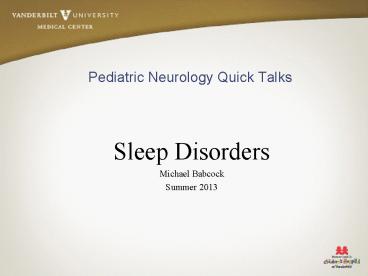Pediatric Neurology Quick Talks PowerPoint PPT Presentation
1 / 12
Title: Pediatric Neurology Quick Talks
1
Pediatric Neurology Quick Talks
- Sleep Disorders
- Michael Babcock
- Summer 2013
2
Scenario
- -4 yo boy
- -screaming at night
- -lasts 30 minutes
- -occurs about 2 hours after going to bed
- -inconsolable during crying, then falls back
asleep - -no bed wetting
- -no limb shaking
- -eyes closed
- -no sedation in the AM
3
Sleep Screen BEARS
- B Bedtime issues
- E Excessive daytime sleepiness (can exhibit as
motor over-activity, inattentiveness,
irritability, oppositional defiance) - A night Awakenings
- R Regularity and duration
- S Snoring
- If concerns
- Movements
- Meds
4
Insomnia
- Onset or Maintenance?
- Usually behavioral
- Psychosocial
- Anxiety (separation)
- Depression
- Medical problems chronic pain, GERD, breathing
problems, medications
5
Insomnia
- Limit-setting subtype
- Older children
- Active resistance to bedtime
- Verbal protests and repeated demands
- Can manifest as fearful behavior (crying,
clinging) - Usually due to caregiver inconsistency with
bedtime rules - Can have medical underlying causes asthma,
medications, sleep disorder RLS, anxiety. - Tx caregiver enforces rules
- Sleep onset Association
- Prolonged night awakenings
- Child has learned to fall asleep with
Associations requiring parents feeding,
rocking, reading can't self-soothe. - Tx break connection put child to be while
drowsy but not asleep.
6
Restless Leg Syndrome
- An urge to move legs, usually accompanied by
unpleasant sensation in legs - These symptoms
- Begin or worsen during rest/inactivity
- Relieved by movement
- Occur exclusively or predominantly in evening
- Not solely accounted for as symptoms of another
medical/behavioral condition
- Hx children may have difficulty explaining this
unpleasant feeling pain should not be only
feeling. - Differential Periodic leg movement disorder
actual leg movements during sleep without
sensation this can be due to other sleep
disorders. - Work-up iron studies
- Tx iron supplementation off label use of
gabapentin, benzo's, clonidine, dopamine agonist
used less often in children.
7
Excessive daytime sleepiness
- A sleepy child may not appear sleepy can be
inattentive, hyperactive (trying to stay awake),
aggressive, disruptive (sleep-deprived frontal
cortex can't regulate emotion) - Insufficient sleep insomnia
- Inadequate sleep hygiene
- Medication side-effects
- Periodic limb movement disorder
- Idiopathic hypersomnia
- endocrine/metabolic problems
- Narcolepsy
- OSA
8
Narcolepsy
- Narcolepsy
- Excessive daytime sleepiness
- Sleep paralysis
- Hypnagogic hallucinations
- Cataplexy
- Sudden loss of tone
- Precipitated by emotion (laughing, anger)
- REM creep
- Dx polysomnography, MSLT
9
Obstructive Sleep Apnea
- Excessive daytime sleepiness
- Symptoms Snoring, with apneic pauses
- But also
- Daytime nasal obstruction
- Mouth breathing
- Trouble eating/meat refusal
- Behavior problems
- Bed-wetting
- Restless sleep
- Sweaty sleep (needs fan on)
- AM headache
- Poor seizure control
- Who has OSA
- 2-3 of normal development children have OSA
- 10 of normal children will be habitual snorers
don't have OSA - 50 of children with Down's
- 50 in obese children
- Why is it bad
- Hypertension, CHF, stroke, diabetes, difficulty
losing weight.
10
Parasomnias
- Sleep-related movement disorders
- Rhythmic movement
- infants/toddlers
- Start at sleep onset
- Head rolling/head banging/body rocking
- Bruxism
- RLS/PLMD
- Hypnic starts
- Brief jerks occurring with falling
asleep/awakening - May have sensation of falling
- Disorders of Non-REM arousal
- Sleep walking
- Sleep terrors
- Confusional arousals
- REM sleep disorders
- Nightmares
- Sleep paralysis
- REM sleep behavior disorder
- Narcolepsy
- SSRI
- neurodevelopmental
11
Non-REM arousal parasomnias
- Usually during first 1/3 of night
- Usually only one event/night
- Increased arousals cause increased problems
- OSA, RLS, GERD.
- Triggered by sleep deprivation, fever.
- Toddler and school-aged kids.
- Usually resolve with time
- sleep-walking most likely to persist.
- Not tired the next day
- No stereotypic motor movements
- Last 5-30 minutes
- Differential nocturnal seizures
- Anytime during night, more often in transition
periods - Last 30 seconds 5 minutes
- Multiple events nightly
- Daytime seizures
- Daytime irritability/lethargy
- Older age of onset.
- Differential panic attack, GERD.
- Dx -home videos, polysomnography or overnight
EEG. - Tx low dose benzo.
12
References
- -Uptodate articles pediatric sleep, NREM sleep
disorders, parasomnias, narcolepsy, RLS

